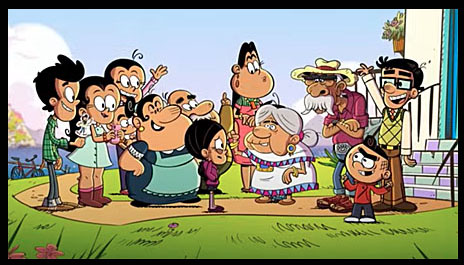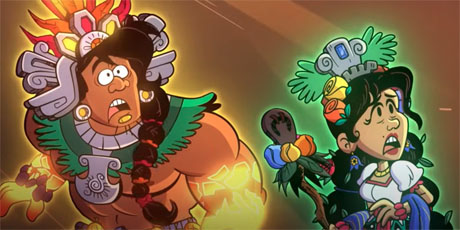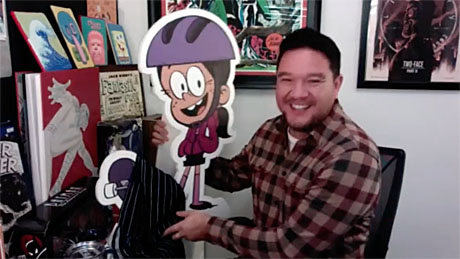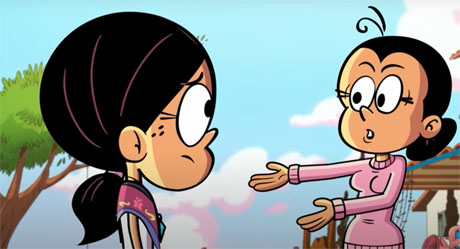
Miguel Puga, who co-developed Nickelodeon’s Loud House spinoff series The Casagrandes, makes his feature directorial debut with The Casagrandes Movie. The epic animated action/adventure comedy premieres this Friday March 22nd on Netflix. Puga shares his enthusiasm for the film, and what fans of the beloved characters should look forward to, in this Animation Scoop Q&A. (This interview was edited for length and clarity.)
Jackson Murphy: Has it sunk in for you yet that you’ve taken this very popular Nickelodeon animated series… and now it’s a movie that millions and millions are just gonna love?
Miguel Puga: It hasn’t yet, but this being my first movie, it’s one of the best experiences I’ve ever had in my entire career. I got to work with some of the best people. Some of my best friends got to work on it. And we got to sit down for almost two years and just make this very epic grande movie with all of them. I’m so glad you really enjoyed it because that’s what we wanted to do. We wanted to make this movie feel like “Goonies” meets a Marvel movie… but still keep it contained in the “Casagrandes” / “Loud House” world. So I hope that’s kind of the area where we ended up, because I really enjoyed it, and we all wanted to do a movie that we wanted to watch.

JM: You pull it off for sure. You start off with this backstory — we go 800 years into the past, and it is quite an open to this movie. Tell me about the origins of it and how you wanted to bring us into this very interesting start of the film.
MP: It started off with Lalo Alcaraz, one of the writers. They approached him to work on the movie first, and even before I even signed on, I think we both said at the same time, “They have to go to Michoacán! They have to go to Mexico!” This is so relatable for a lot of families — spontaneous road trips. If you’re Mexican American, you always get those spontaneous road trips to Mexico over the summer. So that used to happen to me all the time over the summer and I used to hate it. I was like, “I don’t want to go! I want to hang out with my friends. I want to stay here.” But going to Mexico… I love going to Michoacán, which is the part of the area where my family’s from. And it’s just so beautiful and green. And I fell in love with the Purépecha culture, which is an indigenous group in Michoacán. Learning about the culture and how alive and vibrant it is made me kind of want to learn more. So I always had this in my heart, “I want to do something, I want to do something.” So I put in some little sprinkles on the “Casa” series. I wanted to make sure whatever we do represents the Purépecha culture. Thanks so much to Nickelodeon for having us reach out to members from the indigenous group to help us and be cultural consultants on it. So we had Iris Calderon and Kurly Tlapoyawa, who were our cultural consultants, to make sure we did it right. Because we don’t want to just put a blanket over like “Everyone knows what Aztecs are. Everyone knows what Mayans are.”
There’s like 69 indigenous groups in South America. We couldn’t represent all of them, but we wanted to focus on the Purépecha culture. And so that’s where it stems from. I wanted to do something epic. I wanted to bring the gods in. I wanted to show like the sun god, the earth goddess, and Pungari is the demigoddess of the moon — to see what powers and the myth and the cultural significance it could have on anyone that watches it. And we hope that the audience members learn more about their own families’ history and traditions as they watch this movie. That’s one thing I enjoyed the most working on this movie. Learning more about my culture, diving more into it, learning the language.

JM: And this movie is so much about family. Obviously, it’s about the Casagrandes family. But, family at its core, and the emotions that family members have in the joy in going on those spontaneous trips. Those scenes in this movie are very fun, when Ronnie Anne is suddenly going to Mexico with the rest of the gang. And when she meets up with Pungari (who’s 12,000 years old). Ronnie Anne is turning 12. They have a lot in common.
MP: They’re basically going through the same thing. Pungari has a vendetta and wants to become a goddess. Ronnie Anne just wants to do her own thing. That connection with Maria and Ronnie Anne was something we hardly explored on the series. And it was so pivotal that we got to do it on this and make it more of like a mother/daughter movie. Same with Punguari and her mother. And it just brings it home for me because my daughter is 10 right now and I’m gonna take her on a spontaneous trip to Mexico in May. So I hope she doesn’t wake, awaken a 12,000 year old demigoddess. (laughs) But it’s gonna be fun and I can feel she wants to do her own thing. She wants to be her own person. I can see that little person growing up. And that’s how I felt with Ronnie Anne and Maria. I think it’s a great movie for the entire family to watch. It made my wife cry when she watched it. It’s universal. Everyone doesn’t want to let go of their little kid, right?
JM: These themes are universal. And I have to tell you what I think is the best scene in the entire movie. There are a lot of great action and comedic scenes. To me, it’s the three generations of women outside talking about life. That is the poignant powerhouse moment in the film. And it’s one I’m gonna remember for a long time.
MP: We coined it “Chancla Therapy”. And it was by far my favorite sequence in the movie when I first read the script. I couldn’t wait to get it on board and watch it. It was boarded by one of my favorite board artists on the movie Diana Kidlaied, and she did an amazing job because she understood these characters. It’s a pivotal moment because it’s so fun and heartfelt. You could just feel the three generations of women, Chancla warriors, kind of envelop each other, “Hey, we all had to let each other go.”

Miguel Puga
JM: You mentioned being able to do things in terms of the story with this movie that you couldn’t do on the series. And I was thinking as I was watching this, visually too… I feel like there had to be moments in this and sequences and visual cuts and edits that you felt like, “Hey, we got the freedom to be able to try some stuff here that really works.”
MP: Oh yeah, we wanted to go as ambitious and big as we could. On the series, we always focus on the X and Y axis. It’s supposed to be kind of like a Sunday comic. But we wanted to play around with the Z axis and just kind of move the camera, the perspective, add more depth into there and play with the lighting. The lighting could do so much to just a flat background. And to harmonize the characters, we wanted to add some rim light on the character. I know we always get that funny meme where like, “How do you make a TV show into a movie? Oh, you just add a light and a shadow on it.” So we did that, but it was so fun. Miguel Gonzales, the art director, and Caue Zunchini, associate art director, did some amazing work. I loved every paint, every brushstroke, every line work they added to this film, because it’s such a beautiful movie. And it represents Mexico. We’re so used to seeing sepia tone colors in Mexico and dried out desert colors. But with this movie, we really wanted to showcase the beautiful colors you find when you’re in Mexico and especially in Michoacán. There’s so much greenery. I’ve never seen so much.
JM: This film has great daytime scenes and nighttime scenes and fun comedic moments like “Flat Arturo”. I had “Flat Stanley” when I was young. So you get those surreal comedic moments. And I want to ask you about two voice actors that you have in this. The first is Cristo Fernandez, who of course is Dani Rojas on “Ted Lasso”.
MP: Oh, he was the best. We were so excited to have him. And, man, he did some of the best walla. He’s all over in the movie. You can hear him as the people running and screaming in the third act. He was so fun to work with, and I’m a huge fan of “Ted Lasso”. And we actually made Chipini (Punguari’s dad) kind of resemble him. That was the first idea that I had. I wanted to use Cristo from the beginning and I kind of based it off of Cristo, and especially his nice hair, so we kind of gave Punguari the same kind of hairdo. She got that from her dad!

JM: Yeah. And the second person I have to mention is an animation legend, Jorge R. Gutierrez, who has a very pivotal role in the film.
MP: He’s a good friend of mine and I love the guy. We text often and so I always wanted to use him just to kind of give us the blessing like, “Hey, check it out.” We use him on the “Casagrandes” series. So when we got to use them on this, it was so fun, and he delivered some amazing lines. You could hear him screaming too, as well as some of the people running away. He was a lot of fun, and he brought a lot of funny lines to life, where it’s like, “Alright, now we gotta change the animation to match what he’s doing.” Paulina Chavez, who plays Pungari, was… top notch. One of my favorite actors I’ve ever got to work with. She’s such a professional, and she speaks the Purépecha language. She came in prepared, and it’s such a tough language to understand.
JM: Obviously when families go on vacation and trips, they’re taking lots of pictures. What would you say is the biggest snapshot, the biggest memory? One thing from your experience making “The Casagrandes Movie.”
MP: That’s a great question, Jackson. The best thing is seeing the movie done and just working. At the last screening we had and knowing it was in good hands when we sent it over to Netflix. We had mighty animation work on this and they’re from Mexico. And I fought to have it done in Mexico. And I’m so proud. We were so lucky to have them on there. Seeing scenes come back, especially in the third act, some of the action stuff, working with our internal animation team. I got to give it up to Frans Vischer and Mitch Kennedy, who helped us so much. They’re our animation directors. When seeing it completed with the music, with Marcelo Trevino doing the music… I was just so proud, and I may have shed a few tears.
- INTERVIEW: Jeff Fowler On “Knuckles” And “Sonic 3” - April 22, 2024
- INTERVIEW: “Inside Out 2” Director And Producer On Pixar Sequel - April 16, 2024
- INTERVIEW: “Puffin Rock And The New Friends” And 25 Years Of Cartoon Saloon - April 10, 2024


 March 18th, 2024
March 18th, 2024  Jackson Murphy
Jackson Murphy  Posted in
Posted in  Tags:
Tags: 






